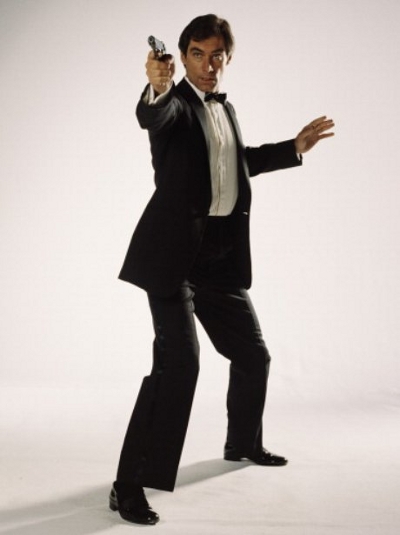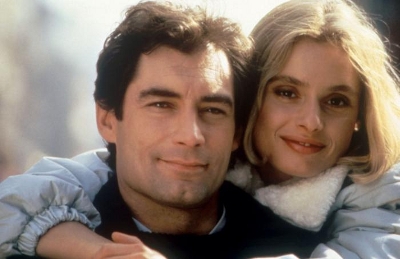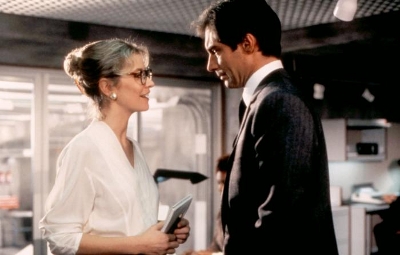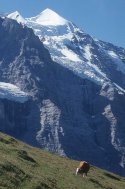|
The Making of The Living Daylights

The Making of The Living
Daylights was written by Charles Helfenstein and published in 2012.
This is a fantastic gift for any Classic Bond fan who would happily
contribute to a Kickstarter raising funds to blast Daniel Craig,
Barbara Broccoli and Sam Mendes into the far reaches of space billions
of light years away from Pinewood Studios. Helfenstein was previously
responsible for a wonderful book about the making of On Her Majesty's
Secret Service and turns his attention here to another pivotal
crossroads in the world of Bondage - the 25th anniversary film and the
first since 1971 that would not feature Roger Moore. For nearly two
decades Moore had been suavely karate chopping henchmen and venturing
forth quips while wearing an assortment of beige jackets, gold buttoned
blazers, cream flares and safari suits. As mocked as he still is in
retrospectives when a new "Bond" film comes out now, usually by idiot
critics with double barrelled names who have probably never even
watched half of the James Bond films, Moore did something that was once
considered to be impossible. He proved that an actor other than Sean
Connery could make the role his own and be popular, ensuring the series
could and would continue with different actors. Who else but Roger
Moore could keep his head above water in a film like Moonraker? The
Living Daylights had a new mission - to prove that James Bond would be
viable into the nineties and beyond. But first they needed a story and
a James Bond and the new Bond actor they eventually landed would
necessitate a major change of direction and tone for the venerable
franchise.
This is an exhaustive
examination of The Living Daylights through screenplays, casting,
production, release, and even gives the reader a tantalising look at
what they had planned for the aborted third Timothy Dalton Bond, a film
that was nixed by tiresome studio litigation and never went into
production. Helfenstein's attention to detail is a trifle pedantic at
times (I don't think I really desperately needed to know the history of
the parrot that features in the Blayden safe house sequence) but the
book is packed with details and trivia and any cinephiles interested in
the production of films and the James Bond franchise should enjoy
reading this a lot. Did you know for example that the original script
treatment for what became The Living Daylights featured Bond as a young
officer in the Royal Navy? Michael G Wilson was the main driver of this
angle, a reboot (I hate that word) that would show us how Bond met M, Q
and Moneypenny for the first time. Wilson's bold concept was ultimately
rejected but at least one potential Bond was screentested with a view
to this brief. British actor Mark Greenstreet was in his mid-twenties
and fresh off a successful television mini-series called Brat Farrar.
When Greenstreet was doing his Bond audition at Pinewood he took a
break to use the toilet and bumped into Michael Biehn in his Corporal
Hicks colonial space marine outfit. James Cameron was shooting Aliens
next door.
If you do have
Helfenstein's book about On Her Majesty's Secret Service you'll be
happy to learn that The Making of The Living Daylights is equally
crammed with never before seen stills, behind the scenes photographs,
publicity shots, memorabilia, deleted scenes and storyboards (where
Bond is, perhaps not surprisingly, drawn to look rather like Roger
Moore). It has often been suggested that The Living Daylights was
originally written for Roger Moore and then changed when it became
apparent that the actor (who was pushing 60 at the time) would not be
returning again. Helfenstein dismisses this assumption and suggests
that if anything the film was developed in a generic way as the
identity of the actor who would play Bond was very up in the air for
periods of pre-production. Helfenstein's thoroughness provokes a
fascinating look too at the Ian Fleming short story from which the
title and parts of the story for The Living Daylights were plucked.
Published posthumously in 1966 in a short story compendium, The Living
Daylights presented a murky look at the shadowy world of "sniper’s
alley" between East and West Berlin. In the story Bond is on stakeout
in a safe house waiting to eliminate a KGB assassin and therefore save
the life of a defecting British agent. Helfenstein details the (as
usual) incredibly comprehensive research that Fleming threw himself
into, visiting locations in Berlin, learning about rifles etc.
Fleming's Bond had a distaste for killing and the agent ruminates on
the sometimes macabre nature of his ruthless profession. Dalton's Bond
managed to capture some of this.

Naturally the casting of the new
James Bond is perhaps the most intriguing subplot of the story of The
Living Daylights and this particular endevour proved to have as many
twists and turns as the final screenplay with its double dealing Cold
War themes. The producers thought they had solved the Bond casting
riddle fairly on when Pierce Brosnan officially signed on the dotted
line to play 007 in The Living Daylights. Cubby Broccoli was always
very high on Timothy Dalton, a serious looking and darkly handsome
classically trained stage actor who was best known for playing Prince
Barin in campy cult classic Flash Gordon. Dalton had turned down the
chance to replace Sean Connery in the late sixties because he felt he
was far too young but Broccoli kept in touch with the actor and had
informal meetings with him in the seventies when Roger Moore would play
extra coy with contract negotiations. But when the 25th anniversary
film loomed and Roger Moore had finally departed, Dalton already had
existing theatrical commitments in the West End so Pierce Brosnan (who
Cubby Broccoli had first noticed in 1981 when Brosnan visited his wife
Cassandra Harris on the set of For Your Eyes only) had a clear run.
Brosnan had begun his 007 costume fittings when fate intervened in
cruel fashion. His television show Remington Steele - a piece of
eighties fluff that had Brosnan as a suave pseudo private eye - was
ailing in the ratings and on the way out but the studio decided to cash
in on the publicity surrounding Brosnan and James Bond and optioned a
new series just as Brosnan's contract was about to expire. Brosnan was
furious and his Bond dream was (until 1994 anyway) shattered.
Helfenstein's passages on the
search to fill Bond's boots in time for the start of shooting are
completely fascinating for those who love what ifs? and alternative
casting that never happened. Why wasn't fan favourite Lewis (Bodie)
Collins a serious contender? Did the elusive Australian model Finlay
Light (who claimed to be close to bagging the part) actually exist? How
close did two other Australians - Antony Hamilton and Andrew Clarke -
come to being cast? Was Hollywood star Mel Gibson (who at this point in
his life had yet to go completely insane) really a contender and would
he have done it? Who else was considered? Read the book for details.
Helfenstein makes a slight error though when he names Trevor
(Shoestring) Eve as one of Eon's chosen candidates as Eve has denied
this was the case. With Brosnan and Dalton apparently out they turned
to New Zealand actor Sam Neil, then something of a rising star after
Reilly Ace of Spies and The Omen III. Neil was screentested and
everyone seemed happy to use him - all that is except for the one
person who really mattered. Cubby Broccoli was never sold on Sam Neill
and when Timothy Dalton unexpectedly became available again the Bond
producer finally managed to sign the man he'd been after for nearly two
decades.
Dalton flew into London on
September the 29th 1986 to begin work on The Living Daylights. Only the
previous day he had finished his stint on a Brooke Shields film called
Brenda Starr in Florida (he needn't have bothered as Brenda Starr sat
on the shelf for two years and bombed when it was released) and with no
rehearsal time was now immediately plunged into the biggest role of his
career. Although Dalton was something of a reluctant Bond (the actor
was a very private person who didn't seem that interested in fame or
money) he impressed everyone with his dedication once ensconced in the
role. Dalton read all the Fleming novels in preparation and was easily
the most intelligent of the men who have played Bond. Dalton would give
interviews where he talked about things like Harold Pinter and
"accidie" - Fleming's definition of boredom and the deadliest of all
sins for James Bond. Ever hear Daniel Craig or George Lazenby waxing
lyrical about Pinter's distilled essence of naturalism and how art is
not reality but the appearance of whatever reality is appropriate? No.
In an age before CGI, Dalton also threw himself into the stuntwork,
giving his stunt handlers kittens throughout his tenure. That jeep
careening down the Rock of Gibraltar? That's Dalton strapped to the
top.

More than anything it was
Dalton's intensity that impressed the crew after years of jovial Roger
Moore extravaganzas. "You really believed he was going to kill him,"
says director of photography Alec Mills on a scene where Dalton's Bond
has to tangle with a villain. Dalton's Byronic good looks and moody
charm in The Living Daylights briefly seemed set to position him as the
definitive screen James Bond but for some reason he never really caught
on with audiences, perhaps a victim of the lacklustre penny pinching
MGM marketing campaigns and summer release dates that were a part of
Bond in those days. Look at how Sony endlessly rammed Skyfall down our
throats last year in their gargantuan marketing blitz. Dalton never got
that fair wind. Dalton's legacy is assessed and there is a chapter on
his death knell Licence To Kill. The book is a treasure trove of
artwork, stills and imagery and the film is I think a great choice for
the author to give this extensive treatment to. Why? In many ways the
Dalton era was really the last of the cinematic James Bond. The Living
Daylights was the last film that Cubby Broccoli produced hands-on
before his age and failing health caught up with him. Dalton's era also
marked the last contributions of the great composer John Barry,
screenwriter Richard Maibaum, titles designer Maurice Binder, actor
Robert Brown as M, and in-house director John Glen to the series. The
Living Daylights was also notably the last Cold War James Bond film
produced.
On the subject of John
Glen, I wouldn't have minded more on the relationship between him and
Dalton. Did they get on? What did Dalton really think of Glen's
directing skills? This book is impressively dense at nearly 300 pages
long and will keep you going for a few days and I loved that the author
included details about the proposed third Dalton film that would would
have arrived circa 1992 had not studio wrangles kyboshed the whole
thing and left Dalton as the two Bond actor that no one remembers. The
script treatment by Michael G Wilson and Alfonse Ruggiero was a far out
gambit set in the Far East with some notable sci-fi trappings. Would it
have been the film that finally established Dalton as Bond in the eyes
of the public? We'll never know. This is an amazing book and well worth
buying but be warned it's fairly expensive at the time of writing. If
you are a fan of the Classic James Bond films and ever see a good deal
then I wouldn't hesitate to get hold of a copy.
- Jake
c 2013
Alternative 007
|

|


